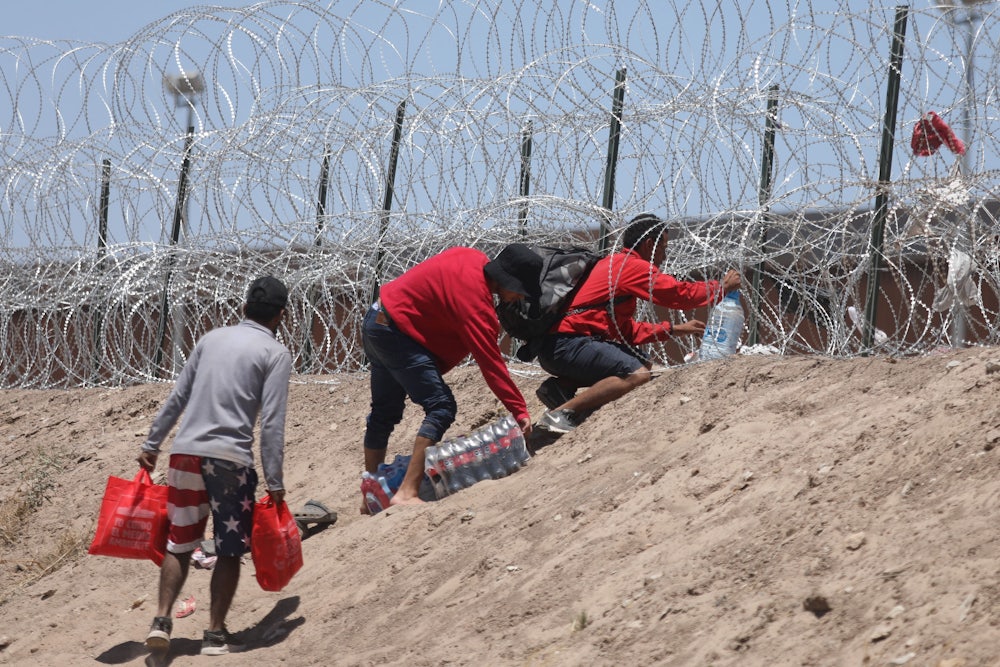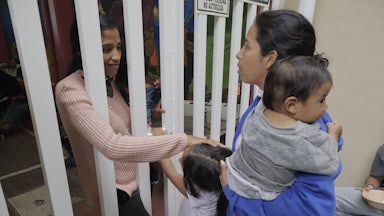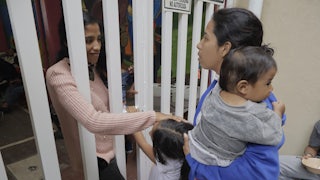The migrants sitting under the tree at Door 40 in Juarez, Mexico, knew that May 11 was an important day, but they couldn’t say exactly why. Most were under the impression they needed to cross the U.S.-Mexico border before that day because no one could give them a good answer for what would happen afterward.
It was 3 p.m. on May 10. The sun was painfully bright, and a dust storm blew a coat of tan powder across everyone’s hair. A group of several hundred people, most of them Venezuelan, gathered in wait; their company included dozens of small children, at least one pregnant woman, and several grandparents. They would spend hours sitting there in the dry heat next to the border wall, the dust enveloping them into the beige landscape.
Thirteen-year-old Karolay left Maracaibo, Venezuela, with her family three months ago. “The trip has been terrible. The worst part is all the walking, kilometers and kilometers, because we don’t have money for the bus. I miss my bedroom,” she said. Karolay has developed a constant dry cough from the dust in her lungs. Their decision to make the journey to the United States was a cumulative one, unanimous among all 11 members of the extended family. Now their odyssey was just hours from its conclusion.
The family has plans: When they’re settled somewhere in the U.S., Karolay is looking forward to attending the eighth grade and learning English, but these dreams will have to wait. As it stands, the family has no idea where they will live. “We’re all tired, we’re all stressed, and that’s what causes arguments. The stress just reaches a level, and we start fighting,” Karolay said. “I’m very ready to be done with this.”
Media outlets and nongovernmental organizations expected a marked increase in attempted crossings on May 11. That was the day that Title 42, a pandemic-era migration loophole, was set to expire. The controversial measure allowed the Border Patrol to expel asylum-seekers from Latin America and the Caribbean back to Mexico—something they did nearly three million times in the past three years, under the ostensible goal of protecting public health. These expulsions could occur without giving the migrants an opportunity to ask for asylum and without issuing a formal deportation order (which would require that the person be sent back to their home country, not to Mexico). Critics of the policy point out that denying a migrant the right to ask for asylum is against both U.S. and international law.
For most asylum-seekers, “crossing the border” does not imply a scheme involving a smuggler and lots of effort being expended to evade Border Patrol. Instead, migrants show up and sit at the border wall, usually at a gate like Door 40, waiting for Border Patrol to arrive, with the hope of turning themselves in to authorities and asking for asylum, an event known as “being processed.”
Many expected that tens of thousands of people would try their luck at crossing the border after the expiration of Title 42, because there would be no risk of being returned to Mexico. But instead of the expected “surge,” border encounters have dropped by half—mainly because migrants, who cannot be expected to possess Ph.D.-level knowledge of immigration law, were convinced they needed to get to the border before that date, not after.
In one sense, their intuition was right. On May 8, the Biden administration unveiled a new policy that looks suspiciously similar to Title 42, only harsher, which would go into effect immediately after the expiration on May 11. The Mexican government agreed to take in 30,000 deported people per month from Venezuela, Cuba, Haiti, and Nicaragua, allowing Border Patrol to continue its expulsions back into Mexico.
This time, however, some migrants may be sent all the way back to Mexico City or even to the Mexico-Guatemala border, forced to make the perilous journey through Mexico once again, this time with likely fewer resources. Also, some deported migrants may be charged fines or issued a notice with the consequence of jail time if they attempt to cross the border again within the next five years. Single adults who ask for asylum will be turned away if they cannot prove they have applied for asylum and been rejected in Mexico or another third country. This new policy, like the ones that came before it, will be applied in a scattered fashion and may be misunderstood by the majority of migrants, who will absorb information on the new policy from anecdotes, not from reading hundreds of pages of legalese.
While these tangled, convoluted policies will have very real effects on the migrants, they will be treated as suggestions by the Border Patrol agents who will decide the fates of thousands of people per day based on split-second perceptions and incomplete information, applying the laws in different ways for different people. In many cases, the specifics of current immigration law are far less important than raw, basic luck. The arbitrary nature of Border Patrol’s decisions makes it common sense to cross again and again until the desired outcome is achieved, or to cross without holding any identification, so Border Patrol cannot keep records of how many times you have tried.
On May 10, migrant shelters in the city of Juarez were clearing out. It seemed everyone wanted to cross the border before May 11, and they were all converging at Door 40, a spot 10 miles down the wall from Paso del Norte, the primary port of entry separating Juarez from El Paso, Texas. Door 40 is effectively in the middle of nowhere, except for a convenience store across the highway. People would leave the group for an hour or two to beg out front for pesos, and would return with sodas and crackers.
Viewing the border from the Mexican side, a hill of blond dirt, rocks, and shrubs rises next to the highway and then lowers to the river, which is barely a stream at Door 40. The true border lies at the midpoint of the river, which has been bridged with a crate, allowing people to hop easily from one side to the other. From there, they proceed up a sharp slope, rimmed with tangled loops of barbed wire, rising five feet high from the ground.
At one spot, the wire has been cut and pushed aside, creating a walking path onto the plateau that sits before the gigantic wall, made of rusted metal slats. The migrants assembled in front of a gate, hardly distinguishable from the rest of the wall, which is so high, when sitting under the tree on the plateau, you have to snap your neck back to see the top of it. Even though they were already technically on U.S. soil, this gate would allow them to cross into the reality of U.S. territory.
At dusk, a fleet of trucks and armored vehicles arrived at the plateau, and a band of heavily armed men representing the National Guard and Border Patrol, some of them in camouflage, emerged to officially process the group of migrants.
Each migrant was given a small, clear plastic bag. Any belongings they held that did not fit in the bag were discarded in piles in the dust. The inventory of abandoned possessions included backpacks worn and fraying from weeks on the road, a child’s purple tennis shoe, a bra, and even documents.
The migrants were then herded onto buses and transported through the gate. Though they spoke to Border Patrol, the migrants would not be given an explicit opportunity to announce their wish to seek asylum. Instead, those traveling in families would be treated as expected asylum-seekers.
Many of the migrants at Door 40 did not know that they should ask for asylum, or that their status would be as asylum-seekers. The word “asilio” prompted confused looks among the group. They knew only that because they were traveling as families, they would be taken to a shelter in El Paso where there would be food and water, and they would be given official papers. The confusing language written on the papers was of little concern—it only mattered that they would be official documents.
The next day, most of the migrants in the original group would be released into El Paso to await court dates for asylum, but a portion of the single adults in the group would be deported back into Juarez under Title 42, seemingly arbitrarily, after spending a day or two in a detention center. These deportations will continue under the new, post–Title 42 policy, but likely with harsher consequences for crossing multiple times.
A young man from Estado Trujillo, Venezuela, who did not want to be named, lived in Juarez for two months and crossed three times unsuccessfully before Border Patrol finally released him into El Paso in the early hours of the morning on May 11. “I thought, why not try one more time before the eleventh? Maybe it’s my last shot. I decided to cross at a different time of day, and it worked. They saw records of all of my previous crossings when they processed me. I don’t think I said anything different this time, but I’m not questioning it,” he said.
In Juarez, he worked as a house painter and slept on the floor of a migrant shelter. One time, Border Patrol left his group of returned migrants near the border wall in an especially dangerous area of Juarez, with no money for transportation. There they waited for hours, until local Juarez police could pick them up.
On May 11, he watched as dozens of young men from his group were escorted into a different van, headed back to Juarez, the process he had lived through three times before. They would be held in a detention center overnight and then dropped off the next day into the custody of INM, the Mexican National Migration Institute, which would take them in vans to a federally operated shelter in Juarez, guarded by men with automatic weapons and strings of bullets at their belts.
Some would likely be sent back to Mexico City or even further south, and some would continue living in Juarez, again, arbitrarily. In one INM detention center, guards demanded $200 if a migrant wished to stay in Juarez—those who could not pay would be shipped south.
José Miguel Arrieta, age 25, also part of the group at Door 40, was worried he would be sent back to Juarez while his pregnant wife was released into El Paso. “For a few hours, we were separated. But I told them I was with her and that she was pregnant, and they understood,” he said, sitting outside the Sacred Heart migrant shelter in El Paso.
Arrieta’s wife, Anabel, found out she was pregnant while the couple was traveling through Honduras. “I only felt joy when I found out—it was completely unplanned, but I only felt joy,” she said.
Their next stop is New York—though at the moment, they don’t have enough money to get there. “We chose New York because someone, an acquaintance, gave me his address there. That’s all we have, an address. I’d like to see Las Vegas,” Arrieta said.
But not everyone crosses the border by waiting for Border Patrol. Ali Jesús Pérez, also from Venezuela, decided to try his luck running through a broken segment of the wall on May 9. He made this decision because he was worried Border Patrol would return him to Juarez and Mexican officials would send him further south if he waited at Door 40. “It was the most terrifying moment of my life—on one side the cartel was chasing me, and on the other side the Border Patrol. There were four wheels everywhere,” he said.
Pérez made it to El Paso, where he received a notice to turn himself in to Border Patrol. Though he was skeptical, he saw other people turn themselves in and return to the shelter safely, so he joined the crowd of those who had crossed “illegally,” seeking documentation of their existence in the United States.
Pérez has 30 days before he must leave El Paso, and 60 days before he must report to Immigration and Customs Enforcement, but he does not know yet what this meeting will entail. If he had crossed several days later, after the expiration of Title 42, it’s possible that upon turning himself in to Border Patrol, he would have been deported into Mexico with the consequence of jail time if he attempted to cross again in the next five years. But the only constant is the inconsistency: It’s also possible this would not have happened.
Most migrants at Door 40 understood on an intuitive level the arbitrary nature of immigration enforcement; how a different Border Patrol agent on a different day could guarantee a better or worse outcome for many people. But a small group of migrants in Juarez, living in a tent city near the Paso del Norte port of entry, trust the system and are determined to cross the border “the correct way.”
Maira Mendoza, from Caracas, Venezuela, said she wanted to migrate “as calmly as possible.” She and her two small children have been living in a tent in Juarez for weeks, patiently refreshing the Border Patrol’s new app, CBPOne, daily. The app keeps crashing as thousands of phones battle for an appointment slot to meet Border Patrol at a port of entry to start the asylum process.
Allowing 1,000 appointments per day through the app was one of President Biden’s initiatives to make migration more orderly. But in reality, Mendoza could wait months for an official appointment to do what those at Door 40 achieved just by sitting in the sun in front of the wall and demanding to be addressed. Living on the street in a neighborhood with significant cartel presence and a high crime rate, Mendoza and her family are at constant risk.
Mendoza’s son, age 3, runs circles around the family’s tent in Spiderman pajamas. “I don’t think the kids know what’s going on—they just think this is normal now,” Mendoza said. “We want to do everything the right way, so we’re prepared to wait here until the app gives us a date.”
Less than a mile away, across the fence, most of the group from Door 40 sat through the end of Title 42 in El Paso shelters, draped in Red Cross blankets. The law was set to expire at 10 p.m., and at Door 40, several Border Patrol and National Guard trucks stood under the stars, poised for the “surge.” Not one migrant came to play deportation roulette with them under the tree. It seemed the only people still in Juarez were those who had tried their luck only to be deported, and those who wished to migrate the correct way.
At this moment, thousands more are on their way through Central America and Mexico to replace those who sat at Door 40. In a week or two, they too will demand to be addressed, and the Border Patrol, armed with a new set of laws, a new set of possible pathways, will decide their fate. They won’t know what rules they’ll be subjected to—and how they’ll be enforced—until they arrive. Title 42 is gone; the hopes of these asylum-seekers remain.










